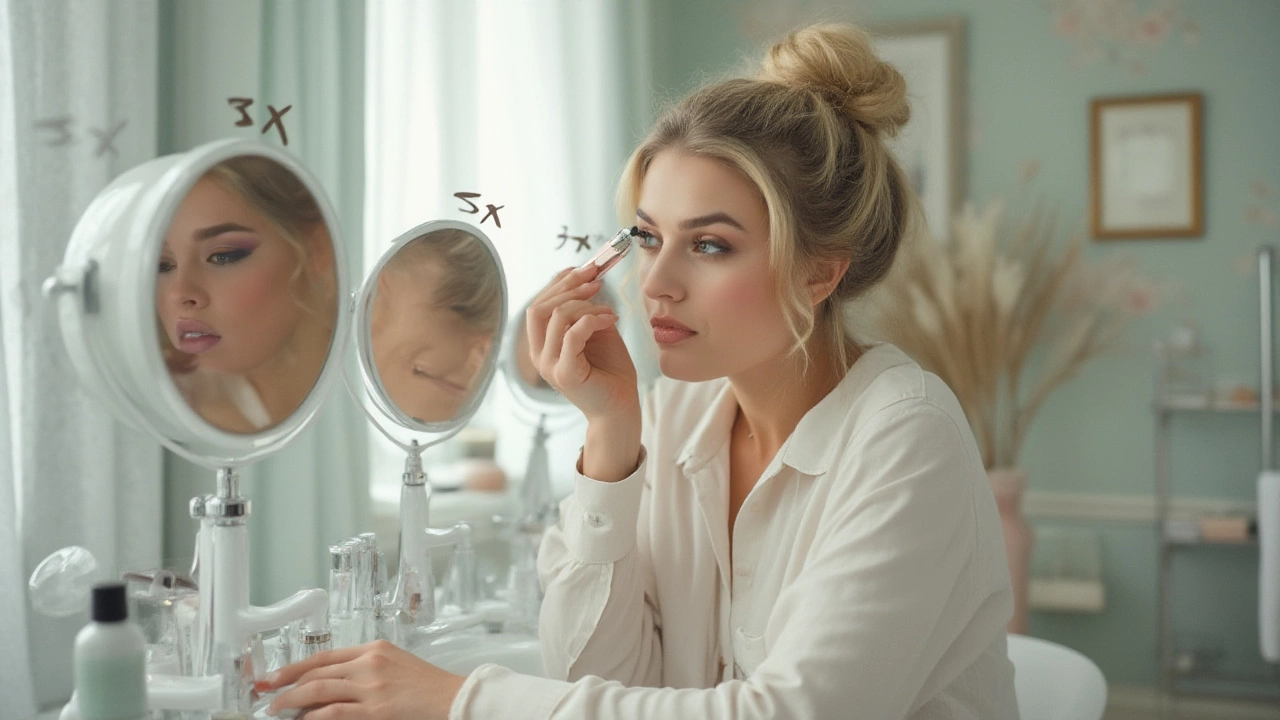Walk into any beauty shop, home goods store, or even your gran’s bathroom, and you’ll spot mirrors claiming to make tweezing, makeup, and shaving a breeze. But have you ever looked in a 10x magnifying mirror and felt like your pores could swallow you whole? Or squinted at your reflection wondering if 3x is doing anything special at all? Choosing the right mirror magnification isn’t just about vanity—it’s about comfort, accuracy, and not accidentally leaving the house with a chunk of mascara on your cheek or a missed spot shaving. With so many options splashed across shelves, it’s easy to feel a bit lost. Let’s cut through the noise and figure out exactly which magnification suits your daily routine—and why.
How Mirror Magnification Really Works
If you’ve tried different mirrors at friends’ houses or hotels, you’ve likely noticed that magnification numbers aren’t just marketing buzzwords. Mirror magnification refers to how many times larger your reflection appears compared to what your eyes see naturally. A 1x mirror? That’s your true self. A 3x mirror? Everything looks three times bigger. Jump to 10x, and suddenly it feels like your skin’s gone digital, every detail enhanced. Here’s the science: convex mirrors curve outward to deliver a wider, smaller image, while concave mirrors curve inwards to focus light and enlarge your reflection at close range. Most makeup and grooming mirrors use this curve to create their enhanced effect.
For a visual break-down, here’s an easy table that shows the real impact of each magnification:
| Magnification | Face Coverage | Best For | Typical Viewing Distance |
|---|---|---|---|
| 1x | Entire face | General use, hairstyling | 30-60 cm |
| 3x | Full face, more details | Basic makeup, shaving | 20-30 cm |
| 5x | Eye area, brows | Brow grooming, eyeliner | 15-20 cm |
| 7x | Very targeted | Tweezing, precise tasks | 10-15 cm |
| 10x | Ultra close-up | Splinter removal, detailed makeup | 5-10 cm |
It’s all about physics: higher magnification shrinks your field of view. Stand too far from a powerful mirror and everything goes blurry. Get too close and you zoom in more than intended. That’s why mirror distance matters as much as magnification—most people hover much closer to 10x glass than 1x. Pro tip: If trying out a mirror in-shop, check if it blurs your reflection unless you practically kiss the glass. That’s a high magnification.
Everyday Scenarios: Makeup, Shaving, and Skincare
Magnifying mirrors aren’t a one-size-fits-all situation. What your best mate swears by for shaving might be a total disaster for your eyeliner. Let’s break it down by daily routines.
Makeup: Here’s where the obsession starts. Foundation looks best in a 1x or 3x mirror—these let you see your entire face and blend evenly. Higher magnifications? Save those for precision. For instance, doing a killer cat-eye wing or applying false lashes? A 5x or 7x mirror makes short work of that. But, ever tried putting on bronzer while staring into a 10x? You lose track of context and risk stripes. According to a 2024 UK beauty survey, 62% of women found 5x perfect for eye and brow work, but only 4% used 10x for whole-face routines—nearly everyone said the ultra-close view made them lose perspective on the result.
Shaving: Men (and women who care for their legs or underarms) have their own needs. Facial shaving often calls for accuracy, especially near patches or tricky chin spots. A 3x is lovely for quick passes, but for detailed work like shaping a beard or handling stray hairs on the neck, a 5x comes in handy. Anything higher, and you risk over-grooming—hello, patchy stubble. If you rely on a straight razor, a 5x or even 7x will show every hair, but don’t linger too long or nothing will look symmetrical anymore.
Skincare: Checking for blemishes, applying spot treatments, or dare I say—blackhead extractions—these call for extra detail. That’s why 7x or even 10x magnification is prized in clinics and by skincare obsessives. But, be careful with these: studies show people using high-magnification mirrors are more likely to pick at harmless bumps, sometimes causing more harm than good. If you just need to see if you’ve missed a cleanser spot, stick to 3x or 5x. Grab 10x only if you’re a steady hand or have a specific task (splinters, for example!).
So, what’s the actual sweet spot? If you could only have one magnifying mirror, most experts recommend 5x. It’s powerful enough for detail, gentle enough not to warp your view of the whole face. Pair it with a regular 1x, and you’ll nail just about every daily beauty or grooming routine without surprises.

Spotlight on Design & Features: What to Look For
Not all magnifying mirrors are created equal. Beyond magnification, design matters. Tilting heads, LED lights, suction mounts, extendable arms—these can make or break your experience. Let’s talk features that actually make a difference, and which ones are just eye candy.
- Lighting: Ever tried plucking your brows in a dim bathroom? Not fun. LED ring lights around the rim are now standard for top brands, mimicking natural daylight and helping avoid makeup mishaps. But beware: cheaper LED strips can cast weird shadows. Natural light is always best, so try to use your mirror near a window in the daytime, if possible.
- Mounting Options: Suction cups stick to tiles and glass—ideal for cramped bathrooms. Gooseneck arms let you pull the mirror right up to your face, then tuck it away. If you have a dedicated vanity, choose a free-standing mirror for stability. Flip mirrors, with one side regular and one side magnified, are the secret weapon of anyone who likes to compare their work as they go.
- Size Matters: Big mirrors offer more surface area, so you see more of your face even with higher magnification. Tiny pocket mirrors are 10x but you’ll only see one eyebrow at a time. Look for a face-sized mirror (about 15–20cm diameter) for versatility.
- Clarity: Cheaply made mirrors sometimes distort or blur around the edges, especially at higher strengths. Check reviews and look for glass mirrors rather than plastic for the clearest reflection. The big giveaway? If things start warping as you move to the sides, it’s not worth the buy.
- Durability: Chrome might look nice but isn’t always ideal in steamy UK bathrooms—it can pit or even rust eventually. Stainless steel, powder-coated surfaces, or solid plastic frames hold up much better over time, especially in humid rooms like the bathroom.
Fun fact: Some of the most popular smart mirrors in 2025 even let you film your routines, zooming in and out digitally based on gestures. Useful or just overkill? Only you know what you really need at half past seven on a sleepy morning.
Tips for Choosing the Right Mirror Magnification for You
Here’s the honest truth—choosing the right magnification is as personal as picking a lipstick shade or razor type. Your vision, your routine, and your lighting all play a part. But some universal tips do help avoid common mistakes.
- Always try before you buy, if possible. Shops like John Lewis usually have display models mounted for testing. Stand at your usual distance and perform your main task (plucking, shaving, makeup). Does it feel right, or is it too much?
- Consider your eyesight. If you wear glasses, take them into account. Higher magnification can sometimes be dizzying for those with contacts or corrective lenses. People with long-sight often need stronger magnification, but don’t go overboard—7x is typically plenty.
- Match your mirror to your daily tasks. If you only use it to check foundation, 3x or 5x will be enough. If you’re a pro at eyeliner or love detail work, upgrade to 7x, but keep a 1x nearby so you can see the big picture before heading out.
- Place your mirror strategically. Good lighting makes every magnification more useful, and placing it where you naturally get ready (rather than deep in a dark cabinet) means you’ll actually use it.
- Don’t forget portability. If you travel or like to do touch-ups at work, look for a folding compact version. Most popular travel mirrors now come with both 1x and 10x sides, but remember—the larger the mirror, the less you’ll have to squint and move it around for a proper view.
- If you live with others, consider their needs too. Shared bathrooms can mean debates over mirrors. Many households solve this with dual-sided swivels (1x/5x or 1x/7x) so everyone’s happy.
One more secret: If you’re buying online, check return policies. There’s nothing worse than splashing out on what you think is the best magnifying mirrors only to discover the image horrifies you—or blurs unless you’re close enough to fog it with your breath.
If you’re still not sure where to start, ask yourself one question tomorrow morning. What’s the main thing I use a close-up mirror for? If the answer is brows: 5x. Foundation? 3x. Precision skin work? Try out 7x and see if you can genuinely handle that harsh a view daily. Most folks discover after a few days that an overly strong mirror ends up in a drawer, while their trusty 3x or 5x gets all the love.

